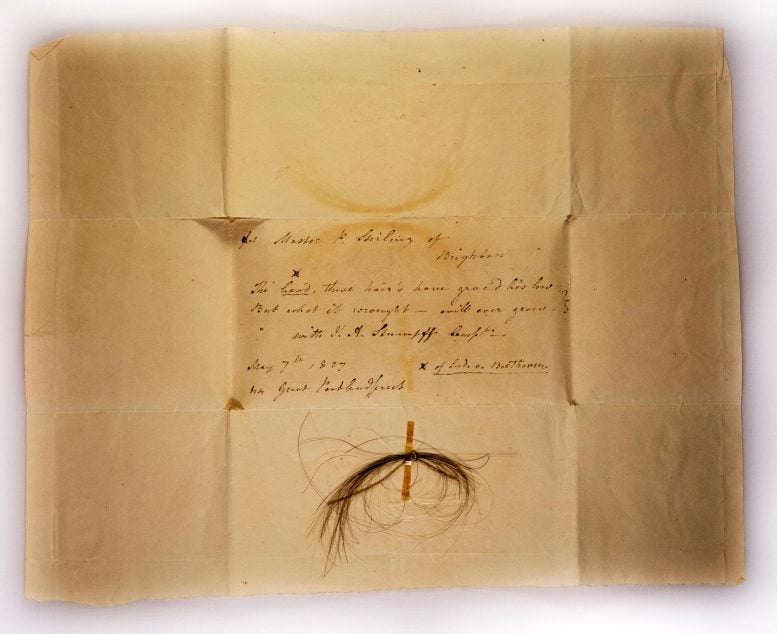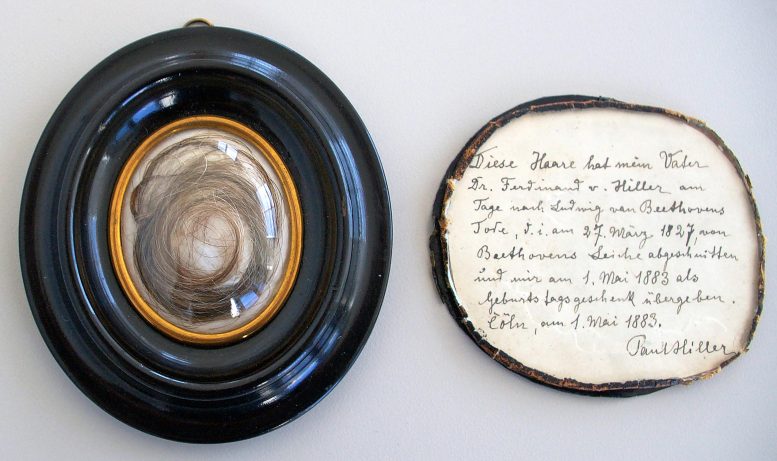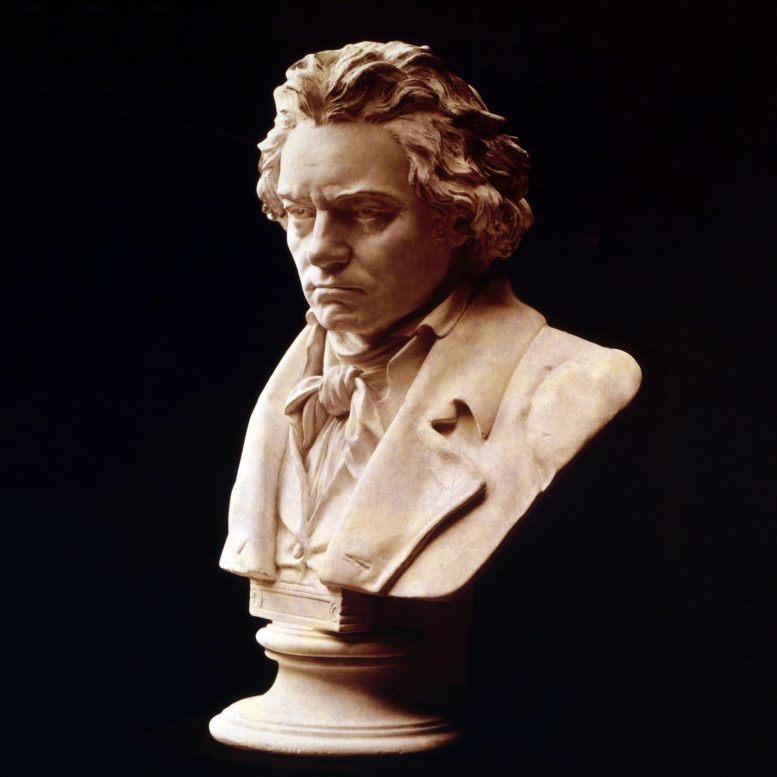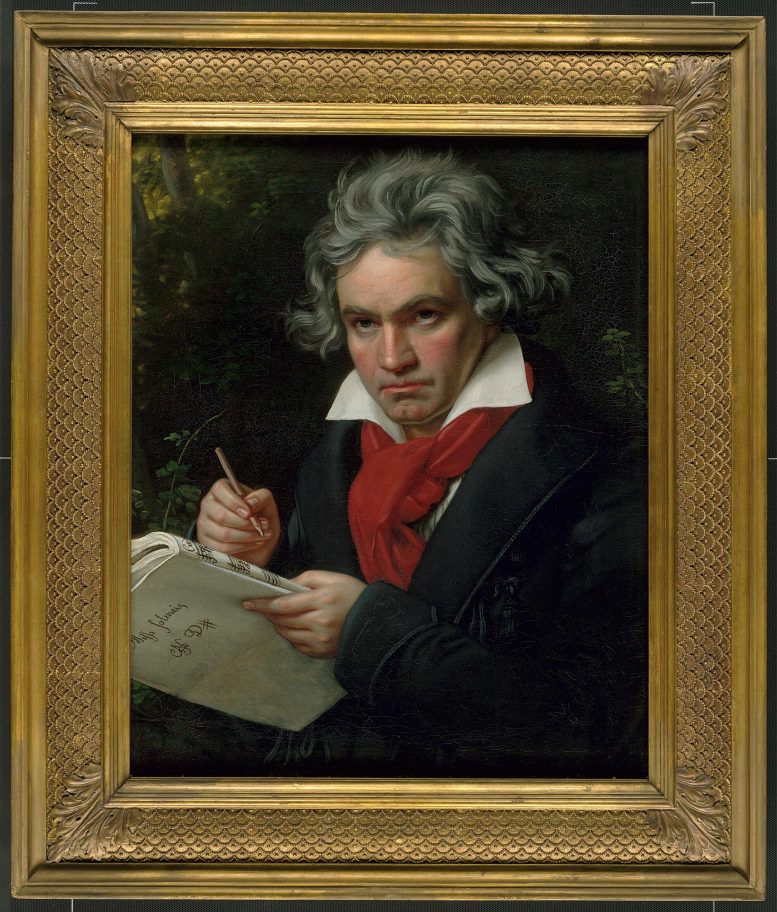
An international team of scientists has sequenced Ludwig van Beethoven’s genome for the first time using five genetically matching locks of the composer’s hair. The research, led by multiple institutions, reveals that Beethoven was predisposed to liver disease, infected with Hepatitis B, and his alcohol consumption may have contributed to his death. Additionally, DNA from modern relatives suggests an extramarital event in his paternal line. The findings provide new insights into Beethoven’s health and cause of death, which have been debated since 1802. The five locks of hair, dating from the last seven years of his life, were determined to be “almost certainly authentic” based on genetic data and provenance histories.
Ludwig van Beethoven’s genome has been sequenced for the first time by an international team of scientists using five genetically matching locks of the well-known composer’s hair.
- International team of scientists deciphers renowned composer’s genome from locks of hair.
- Study shows Beethoven was predisposed to liver disease, and infected with Hepatitis B, which – combined with his alcohol consumption – may have contributed to his death.
- DNA from modern relatives points to an extramarital ‘event’ in Beethoven’s paternal line.
The research, led by the University of Cambridge, the Beethoven Center San Jose and American Beethoven Society, KU Leuven, FamilyTreeDNA, the University Hospital Bonn and the University of Bonn, the Beethoven-Haus, Bonn, and the Max Planck Institute for Evolutionary Anthropology, uncovers important information about the composer’s health and poses new questions about his recent ancestry and cause of death.
In 1802, Beethoven asked his doctor to describe his illness and to make this record public. The great man’s health and cause of death have been debated ever since, but without the benefit of genetic research.
Research published in Current Biology shows that DNA from five locks of hair – all dating from the last seven years of Beethoven’s life – originate from a single individual matching the composer’s documented ancestry. By combining genetic data with closely examined provenance histories, researchers conclude these five locks are “almost certainly authentic.”
The study’s primary aim is to shed light on Beethoven’s health problems, which famously include progressive hearing loss, beginning in his mid- to late-20s and eventually leading to him being functionally deaf by 1818. The team also investigated possible genetic causes of Beethoven’s chronic gastrointestinal complaints, and a severe liver disease that culminated in his death in 1827.
Beginning in his Bonn years, the composer suffered from “wretched” gastrointestinal problems, which continued and worsened in Vienna. In the summer of 1821, Beethoven had the first of at least two attacks of jaundice, a symptom of liver disease. Cirrhosis has long been viewed as the most likely cause of his death at age 56.
Genetic clues to Beethoven’s health
The team of scientists were unable to find a definitive cause for Beethoven’s deafness or gastrointestinal problems. However, they did discover a number of significant genetic risk factors for liver disease. They also found evidence of an infection with hepatitis B virus in at latest the months before the composer’s final illness.
Lead author, Tristan Begg, from the University of Cambridge, said:
“We can surmise from Beethoven’s ‘conversation books’, which he used during the last decade of his life, that his alcohol consumption was very regular, although it is difficult to estimate the volumes being consumed. While most of his contemporaries claim his consumption was moderate by early 19th century Viennese standards, there is not complete agreement among these sources, and this still likely amounted to quantities of alcohol known today to be harmful to the liver. If his alcohol consumption was sufficiently heavy over a long enough period of time, the interaction with his genetic risk factors presents one possible explanation for his cirrhosis.”

The Stumpff Lock, from which Beethoven’s whole genome was sequenced, with inscription by former owner Patrick Stirling. Credit: Kevin Brown
The research team also suggests that Beethoven’s hepatitis B infection might have driven the composer’s severe liver disease, exacerbated by his alcohol intake and genetic risk. However, scientists caution that the nature and timing of this infection – which would have greatly influenced its relationship with Beethoven’s liver disease – could not currently be determined, and similarly caution that the true extent of his alcohol consumption remains unknown.
Beethoven’s hearing loss has been linked to several potential causes, among them diseases with various degrees of genetic contributions. Investigation of the authenticated hair samples did not reveal a simple genetic origin of the hearing loss. Dr. Axel Schmidt at the Institute of Human Genetics at the University Hospital of Bonn, said:
“Although a clear genetic underpinning for Beethoven’s hearing loss could not be identified, the scientists caution that such a scenario cannot be strictly ruled out. Reference data, which are mandatory to interpret individual genomes, are steadily improving. It is, therefore, possible that Beethoven’s genome will reveal hints for the cause of his hearing loss in the future.”

The Hiller Lock, which the study found did not come from Beethoven but a woman, with inscription by former owner Paul Hiller. Credit: Ira F. Brilliant Center for Beethoven Studies, San Jose State University. Photo by William Meredith
It proved impossible to find a genetic explanation for Beethoven’s gastrointestinal complaints, but the researchers argue that coeliac disease and lactose intolerance are highly unlikely based on the genomic data. Beethoven was also found to have a certain degree of genetic protection against risk of irritable bowel syndrome (IBS), often suspected as a cause, rendering this a less likely explanation.
“We cannot say definitely what killed Beethoven, but we can now at least confirm the presence of significant heritable risk, and an infection with hepatitis B virus,” said Johannes Krause, from the Max Planck Institute of Evolutionary Anthropology. “We can also eliminate several other less plausible genetic causes.”
“Taken in view of the known medical history, it is highly likely that it was some combination of these three factors, including his alcohol consumption, acting in concert, but future research will have to clarify the extent to which each factor was involved,” Tristan Begg adds.
Authenticating Beethoven’s hair
In total, the team conducted authentication tests on eight hair samples acquired from public and private collections in the UK, continental Europe and the US. In doing so, the researchers discovered that at least two of the locks did not originate from Beethoven, including a famous lock once believed to have been cut from the recently deceased composer’s head by the 15-year-old musician Ferdinand Hiller.
Previous analyses of the ‘Hiller lock’ supported the suggestion that Beethoven had lead poisoning, a possible factor in his health complaints, including his hearing loss. William Meredith, who was part of a team involved in earlier scientific analyses of Beethoven’s remains and initiated the present study with Tristan Begg, said: “Since we now know that the ‘Hiller lock’ came from a woman and not Beethoven, none of the earlier analyses based solely on that lock apply to Beethoven. Future studies to test for lead, opiates, and mercury must be based on authenticated samples.”

Ludwig van Beethoven (1770-1827) was a legendary German composer and pianist who made an indelible mark on the world of classical music. Born into a musical family, he started his career as a prodigy, eventually becoming one of the most celebrated and influential composers in history. Beethoven’s works spanned various periods of music, including the Classical and Romantic eras. His compositions, such as the Ninth Symphony, Fifth Symphony, and Moonlight Sonata, have become timeless masterpieces. Despite losing his hearing in later life, Beethoven continued to compose, demonstrating his resilience and dedication to his art.
The five samples identified as being authentic and from the same person belong to the Ira F. Brilliant Center for Beethoven Studies in San Jose, California; to a private collector, American Beethoven Society member Kevin Brown, and to the Beethoven-Haus in Bonn. Beethoven hand-delivered one of the locks (now in Brown’s collection) to the pianist Anton Halm in April 1826 telling him “Das sind meine Haare!” (“That is my hair!”). Beethoven’s whole genome was sequenced from another of Brown’s samples, the ‘Stumpff Lock’, which emerged as the best-preserved sample. The team found the strongest connection between the DNA extracted from the Stumpff lock of Beethoven’s hair and people living in present day North Rhine-Westphalia, consistent with Beethoven’s known German ancestry.
A family mystery
The team analyzed the genetics of living relatives in Belgium but could not find matches among either of them. Some of them share a paternal ancestor with Beethoven in the late 1500s and early 1600s based on genealogical studies, but they did not match the Y-Chromosome found in the authentic hair samples. The team concluded that this was likely to be the result of at least one “extra-pair paternity event” – a child resulting from an extramarital relationship – in Beethoven’s direct paternal line. Genetic genealogist Maarten Larmuseau from the KU Leuven said:
“Through the combination of DNA data and archival documents, we were able to observe a discrepancy between Ludwig van Beethoven’s legal and biological genealogy.”
The study suggests that this event occurred in the direct paternal line between the conception of Hendrik van Beethoven in Kampenhout, Belgium in c.1572, and the conception of Ludwig van Beethoven seven generations later in 1770, in Bonn, Germany. Although a doubt had earlier been raised concerning the paternity of Beethoven’s father owing to the absence of a baptismal record, the researchers could not determine the generation during which this event took place.
Begg said: “We hope that by making Beethoven’s genome publicly available for researchers, and perhaps adding further authenticated locks to the initial chronological series, remaining questions about his health and genealogy can someday be answered.”
For more on this research study, see A Hairy Tale of Beethoven’s Maladies: The Genetic Key to His Life’s Crescendo.
Reference: “Genomic analyses of hair from Ludwig van Beethoven” by Tristan James Alexander Begg, Axel Schmidt, Arthur Kocher, Maarten H.D. Larmuseau, Göran Runfeldt, Paul Andrew Maier, John D. Wilson, Rodrigo Barquera, Carlo Maj, András Szolek, Michael Sager, Stephen Clayton, Alexander Peltzer, Ruoyun Hui, Julia Ronge, Ella Reiter, Cäcilia Freund, Marta Burri, Franziska Aron, Anthi Tiliakou, Joanna Osborn, Doron M. Behar, Malte Boecker, Guido Brandt, Isabelle Cleynen, Christian Strassburg, Kay Prüfer, Denise Kühnert, William Rhea Meredith, Markus M. Nöthen, Robert David Attenborough, Toomas Kivisild and Johannes Krause, 22 March 2023, Current Biology.
DOI: 10.1016/j.cub.2023.02.041










What about the findings years earlier of an analysis of a piece of his skull bone showing fatal amounts of lead?
We knew zero. Now we know zero .